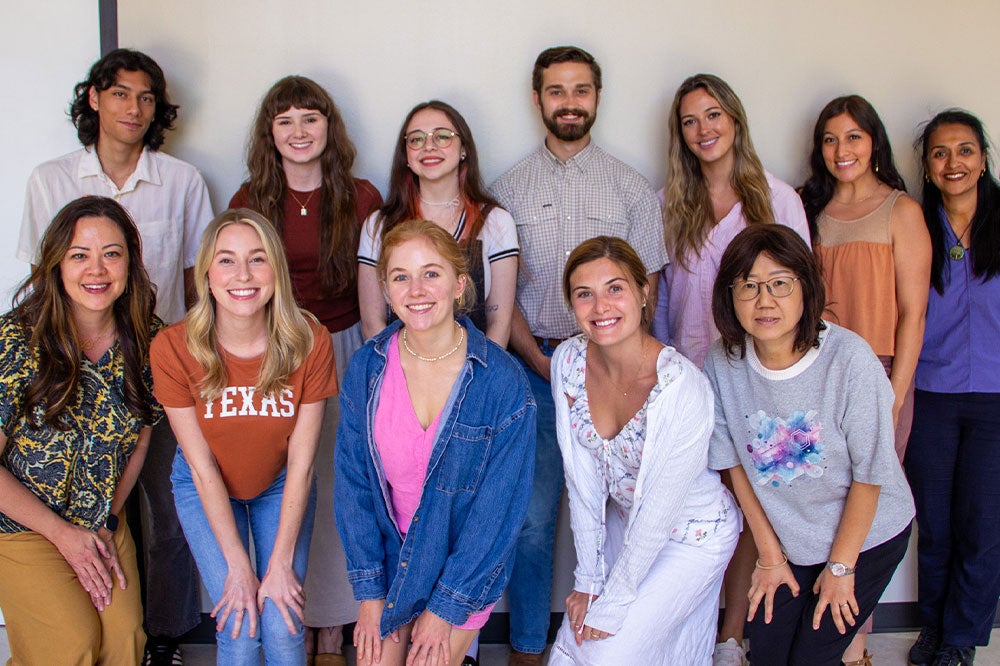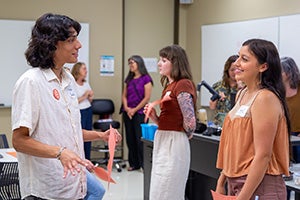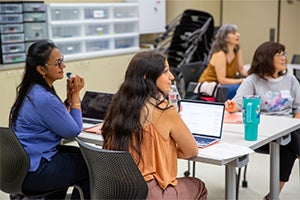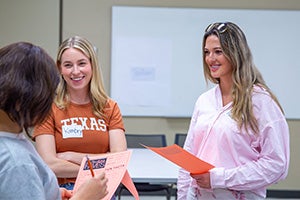
The first day of school will look different for the inaugural cohort of UT’s first teacher residency program as they take on the classroom – both as teachers and students.
Longhorns in Residence is COE’s latest innovative effort to prepare highly qualified educators while working to address the state’s growing teacher shortage. The graduate-level program, which consists of paid residency opportunities at participating local schools and results in both a teacher certification and graduate certificate, welcomed a first round of applicants this year.
This month, the inaugural cohort of residents will be placed in elementary schools across participating Central Texas districts based on their career goals and district needs. By the end of the year-long program, participants will be certified to teach in early childhood through sixth grade with a supplemental ESL certification.
In Texas, the need to serve the state through high-quality educators who are certified to teach in the areas that they are teaching is a key need,
said Melissa Wetzel, who chairs the Department of Curriculum and Instruction and helped design the program.
According to Wetzel, Longhorns in Residence will aim to combat both the teacher shortage and the rise of uncertified teachers by helping campuses meet staffing needs and creating a certification to classroom pipeline for partner districts.

Last year, COE researchers’ data analysis showed a growing number of uncertified teachers in Texas public schools. Results presented to state lawmakers informed legislative action this spring, when lawmakers passed the first major education funding bill since 2019 that included an allotment for educator preparation.
Wetzel said programs that create a pipeline of certified teachers are important because the data has shown students exhibit more learning growth when their teachers are certified in their subject areas, especially at the early childhood age.
This model is significant in that it also provides the necessary experience for teachers during their certification process which allows them to feel more prepared when they become the teacher of record the following year, leading to lower turnover rates.
This is an effort from the flagship state institution to serve the needs of the state, the people of Texas, schools, families and communities,
said Allison Skerrett, COE’s associate dean for academic affairs, who helped create the program.
According to the program’s leaders, Longhorns in Residence is the culmination of a years-long goal of Dean Charles Martinez’s to start a residency program that could accelerate the path to the classroom, as well as efforts from leaders across the college and outside partner organizations like the Texas Education Agency and the National Center for Teacher Residencies.
It comes in the wake of a popularization of the teacher residency certification model across Texas and nationally due to the in-person, in-depth practice element of the process.
We started thinking with the move to teacher residency programs across the state about how we might create something that ultimately helped us to do what we already do really well in a more accelerated fashion,
Skerrett said.
Typically, COE students receive their basic courses during the first two years of their bachelor’s degree, then spend the last two learning about educational practices and completing student teaching. Additionally, there are alternative teacher certification programs, the quality and rankings of which vary.

This, Skerrett said, is a flipping of the traditional model.
The newly designed teacher certification program will allow participants to work three to four days per week co-teaching with a host teacher at a partner campus from the first to the last day of school while completing graduate coursework taught by UT faculty in a flexible, online format. Meanwhile, site coordinators will collaborate with campus leaders and host teachers to provide real-time feedback from instruction to application, including how to best support and coach residents.
The mentorship aspect will give student teachers the opportunity to observe a seasoned teacher at the start of the residency experience and learn how to make decisions, set up a classroom and prepare for a new school year. Over time, residents will take up more and more responsibility in the host teacher’s classroom.
Spending a full year in a host teacher’s classroom gives residents a complete model of a successful school year to apply when they become the teacher of record,
said Sarah Johnson, the program’s project manager.
Jennifer Dunn, Elementary Teacher Recruiter at Leander Independent School District, said they became aware of the program because they have several student teachers advancing through the UTeach program and have a long history of hiring COE alumni. According to Dunn, the history of quality educator preparation that they have witnessed from the College of Education led them to invest in the residency program after nearly half a decade of seeking the right fit for a residency partner.
When we saw how they laid out the program, it was exactly what we had been envisioning for a residency program to look like,” Dunn said. “We could tell that they had very intentionally thought about support not only for our student teachers but also our mentor teachers.
Dunn compares the program to the support system physicians experience when entering the healthcare field.
For years, we have just thrown people in a classroom and then they are barely keeping their head above the water,
Dunn said. In a residency, you are alongside a mentor who is good in their practice, and you can see what this really is about.
In the future, the program coordinators’ goal is to expand to additional certification areas and to expand to other school districts to help address teacher shortage needs across the state. The challenge: residencies are the most expensive way to prepare teachers because partner districts financially support the program by paying residents for their teaching services.

For some districts, especially those already struggling financially, this means they must pick and choose how many residents they are able to fund each year and hope that these will help fill shortage gaps by remaining with the district permanently after completing the program.
Ericka Jones, who leads partnerships and residencies at Austin ISD, and has worked collaboratively with the College of Education shared that while the cost of teacher preparation is high, the return is invaluable.
It’s worth the investment when we prioritize student outcomes and support well-prepared teachers who feel ready from day one,
said Jones. These teachers are more likely to stay in the classroom, and our students benefit most when they learn from educators with a strong foundation. That’s our north star.

